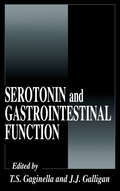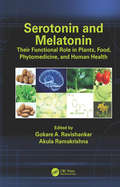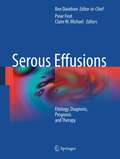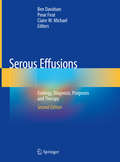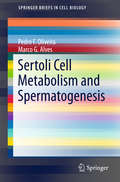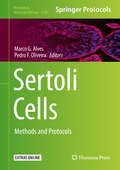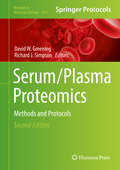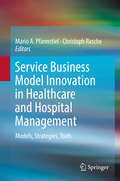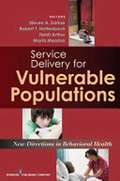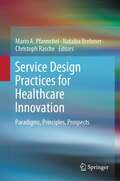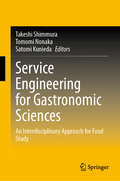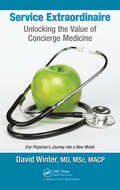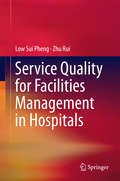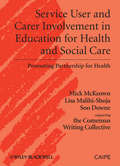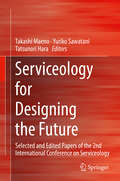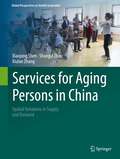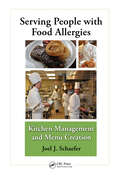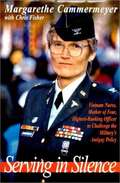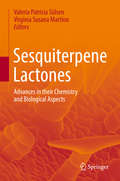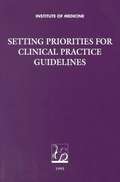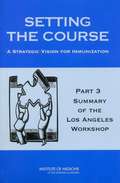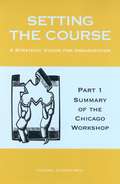- Table View
- List View
Serotonin and Gastrointestinal Function (Handbooks In Pharmacology And Toxicology Ser. #23)
by Timothy S. Gaginella James J. GalliganSerotonin and Gastrointestinal Function provides a comprehensive review of current research into the mechanisms by which serotonin acts on gastrointestinal tissues. This book covers neurochemistry, physiology, pharmacology, and clinical issues relevant to serotonin in the gastrointestinal tract. The editors have brought together the most relevant information from the molecular to the clinical level. Each chapter is written by investigators experienced in research on serotonin's actions in the gut. This book will be useful to basic scientists, clinical investigators, graduate and postgraduate students.
Serotonin and Melatonin: Their Functional Role in Plants, Food, Phytomedicine, and Human Health
by Gokare A. Ravishankar Akula RamakrishnaSerotonin and Melatonin: Their Functional Role in Plants, Food, Phytomedicine, and Human Health highlights the significance of the plant sources of serotonin and melatonin in the fields of medicine, agriculture, and food science. Over the last few decades, an enormous amount of research data has been generated on these two neurotransmitters/plant signalers. This book covers topics regarding the occurrence of serotonin and melatonin in medicinal plants and food value plants with their implications for human health, the role of serotonin and melatonin in plant growth development, functions of melatonin and serotonin in the environmental adaptation of plants, and the implications of these molecules in human disorders and treatments. This volume should appeal to scientists and other professionals engaged in basic and applied research on the relevance of serotonin and melatonin to plants, animals, and humans. Features Reviews the global scientific literature and the experimental data of the authors on the occurrence of serotonin and melatonin in medicinal and food value plants and its implications for human health Explains in detail the role of serotonin and melatonin in plant growth development Helps in understanding the complex functions of melatonin and serotonin in the environmental adaptation in plants Discusses the importance of the development of transgenic plants with high amounts of serotonin and melatonin. Describes the current understanding of serotonin and melatonin in human disorders, and also their relevance in the treatment of specific health conditions. Written by acknowledged experts from across the world
Serous Cavity Fluid and Cerebrospinal Fluid Cytopathology
by Edmund S. Cibas Syed Z. AliCytologic diagnosis by examination of exfoliated cells in serous cavity fluids is one of the most challenging areas in clinical cytopathology. Almost 20% of the effusions examined are directly or indirectly related to the presence of malignant disease, with carcinoma of the lung as the most common underlying culprit. This volume published in the Essentials in Cytopathology book series will fulfill the need for an easy-to-use and authoritative synopsis of site specific topics in cytopathology. These guide books fit into the lab coat pocket, ideal for portability and quick reference. Each volume is heavily illustrated with a full color art program, while the text follows a user-friendly outline format.
Serous Effusions
by Claire W. Michael Pinar Firat Ben DavidsonSerous (peritoneal, pleural and pericardial) effusions are a frequently encountered clinical finding in everyday medical practice and one of the most common specimen types submitted for cytological evaluation. The correct diagnosis of effusions is critical for patient management, as well as for prognostication and yet many clinicians find diagnosis and treatment of cancer cells in effusions very challenging. Featuring multiple microscopic illustrations of all diagnostic entities and ancillary techniques (immunhistochemistry and molecular methods), this book provides a comprehensive, authoritative guide to all aspects of serous effusions, including etiology, morphology and ancillary diagnostic methods, as well as data related to therapeutic approaches and prognostication. Section one covers diagnosis for benign and malignant effusions including the etiological reasons for the accumulation of effusions that provides the reader with the full spectrum of differential diagnoses at this anatomic site. Section Two discusses biology, therapy and prognosis highlighting clinical approaches that may be of value to patients and the movement towards personalized medicine and targeted therapy. Written by experts in the field internationally, Serous Effusions will provide an indispensible guide to all aspects of current practice for cytopathologists, cytotechnicians, pathologists, clinicians and researchers in training and practice.
Serous Effusions: Etiology, Diagnosis, Prognosis and Therapy
by Claire W. Michael Pinar Firat Ben DavidsonThis revised and updated second edition contains multiple microscopic illustrations of all diagnostic entities and ancillary techniques, providing a comprehensive, authoritative guide to all aspects of serous effusions. It now includes the many new antibodies which have been tested since the previous edition, as well as a discussion on next-generation sequencing and molecularly targeted therapy.Section one covers diagnosis for benign and malignant effusions while section two discusses biology, therapy, and prognosis highlighting clinical approaches that may be of value.Serous Effusions provides an indispensable guide to all aspects of current practice for cytopathologists, cytotechnicians, pathologists, clinicians and researchers in training and practice.
Sertoli Cell Metabolism and Spermatogenesis
by Pedro F. Oliveira Marco G. AlvesThis book is focused on Sertoli cell physiology and its role in the spermatogenic event. These cells, known as "nurse cells", are essential for the normal development of germ cells by offering not only physical support and creating an immune-privileged environment, but also for providing nutritional support. The presence of Sertoli cells promotes the establishment of the appropriate microenvironment so that spermatogenesis may occur. Spermatogenesis maintenance in vivo is highly dependent on the metabolic cooperation established between Sertoli cells and developing germ cells. For many years this metabolic cooperation between testicular cells has been disregarded, but recent advances have highlighted the relevance of these processes for male fertility. Thus, the understanding of the functioning and regulation of these metabolic processes is a crucial step to identify key mechanisms associated with Sertoli cell (dys)function and to enlighten their influence on male fertility.
Sertoli Cells: Methods and Protocols (Methods in Molecular Biology #1748)
by Pedro F. Oliveira Marco G. AlvesThis detailed volume explores the use of Sertoli cells as models in male reproductive biology or as supporters for other cell types, and it answers the need for standardized protocols for their in vitro culture. Prepared for non-specialists as well as experienced researchers that may be interested in a multidisciplinary approach to study these cells, the book examines these remarkable cells that present some unique features that go far beyond the physical and nutritional support of spermatogenesis. Written for the highly successful Methods in Molecular Biology series, chapters include introductions to their respective topics, lists of the necessary materials and reagents, step-by-step, readily reproducible laboratory protocols, and tips on troubleshooting and avoiding known pitfalls. Authoritative and practical, Sertoli Cells: Methods and Protocols serves as a valuable resource for experienced researchers in reproductive biology, particularly andrologists, but also for future investigators and young students starting to study these extraordinary cells.
Serum/Plasma Proteomics
by David W. Greening Richard J. SimpsonBlood science has become a cornerstone of multiple disciplines, including clinical chemistry, disease diagnosis, and therapeutic monitoring. Over the past decade, we have witnessed the advent of increasingly powerful proteomics technologies that allow greater fundamental insights into the blood proteome. These technological improvements have, in part, fuelled the quest for the discovery of novel blood-based biomarkers of disease. Serum/Plasma Proteomics: Methods and Protocols is a comprehensive resource of protocols for areas, pre-analytical through to analytical, of plasma and serum proteomics. Divided into five convenient sections, this detailed volume covers fractionation strategies for in-depth blood proteome analysis, defined procedures for blood collection, handling and storage, detailed protocols for performing both antibody-based and non-antibody based quantitative assays, proteome analysis of blood cell compartments, circulating nanomebraneous vesicles and blood-related fluids, and finally data management, statistical design, and bioinformatic challenges. This book, contributed to by leading experts in the field, provides a valuable foundation for the development and application of blood-based proteomics. Written in the highly successful Methods in Molecular Biology(tm) series format, chapters contain introductions to their respective topics, lists of the necessary materials and reagents, step-by-step, readily reproducible laboratory protocols, and notes on troubleshooting and avoiding known pitfalls. Authoritative and easily accessible, Serum/Plasma Proteomics: Methods and Protocols, with its well-honed methodologies, seeks to serve both professionals and investigators new to the field in an effort to further our knowledge of this fundamental science.
Service Business Model Innovation in Healthcare and Hospital Management
by Mario A. Pfannstiel Christoph RascheThis book demonstrates how to successfully manage and lead healthcare institutions by employing the logic of business model innovation to gain competitive advantages. Since clerk-like routines in professional organizations tend to overlook patient and service-centered healthcare solutions, it challenges the view that competition and collaboration in the healthcare sector should not only incorporate single-end services, therapies or diagnosis related groups. Moreover, the authors focus on holistic business models, which place greater emphasis on customer needs and put customers and patients first. The holistic business models approach addresses topics such as business operations, competitiveness, strategic business objectives, opportunities and threats, critical success factors and key performance indicators. The contributions cover various aspects of service business innovation such as reconfiguring the hospital business model in healthcare delivery, essential characteristics of service business model innovation in healthcare, guided business modeling and analysis for business professionals, patient-driven service delivery models in healthcare, and continuous and co-creative business model creation. All of the contributions introduce business models and strategies, process innovations, and toolkits that can be applied at the managerial level, ensuring the book will be of interest to healthcare professionals, hospital managers and consultants, as well as scholars, whose focus is on improving value-generating and competitive business architectures in the healthcare sector.
Service Delivery For Vulnerable Populations: New Directions In Behavioral Health
by Steven Estrine[This book] provides a comprehensive understanding of the opportunities for all of us working with vulnerable populations to develop thoughtful, workable programs. The topics presented are not limited to the severely mentally ill, but it is an encyclopedia of resources and creative options for service to veterans, the homeless, the elderly. This book challenges us to think creatively and develop programs and services for the people in our society who are most often overlooked and forgotten.
Service Design Practices for Healthcare Innovation: Paradigms, Principles, Prospects
by Mario A. Pfannstiel Christoph Rasche Nataliia BrehmerThis book offers an overview of service design practices for healthcare and hospital management. It explores how these practices can help to generate innovations in healthcare and contribute to the improvement of patient-centered care. Respected experts, including scholars from various disciplines and practitioners from healthcare institutions, share essential insights into established research areas, fields of work and work structures, and discuss successful approaches, methods and tools. By illustrating innovative services, products, processes, systems, and technologies, as well as their application in practice, the authors highlight the role of participating stakeholders in service design projects and the added value that comes from sharing, communicating, networking and collaborating. This book is a must-read for scholars and practitioners in the hospital and healthcare sector. It will also appeal to anyone interested in organizational development, service business model innovation, customer involvement and perceptions, and service experience.
Service Engineering for Gastronomic Sciences: An Interdisciplinary Approach for Food Study
by Takeshi Shimmura Tomomi Nonaka Satomi KuniedaThis pioneering book on food study pursues an interdisciplinary approach to service science and the service engineering field. Further, it highlights a range of experiments conducted at actual business sites to verify the effectiveness of the proposed methodologies and theories. In modern society, food study has become more complex, as it involves multiple fields of science. For instance, a long-lived society entails a number of problems for human beings. A balanced intake of nutrients is important for a healthy life, but in many cases, healthy food is not the most enjoyable. As such, it is important for the food industry to provide foods that are both tasty and wholesome, based on the sciences of gastronomy and nutrition. Conventional food study proceeds along the lines of a specific field such as nutrition, agriculture, or gastronomy, though it should be conducted in an interdisciplinary manner. This book covers multifaceted research on food study to respond to today’s societal demands, based mainly on the natural and social sciences. It addresses a wide range of topics, including: food production management using mathematical modeling, operations research, and production engineering; evaluation of food products based on big data analysis; psychological experiments and ethnography; food products based on consumer behavior; organoleptic assessment and health improvement; design of physical dining environments using virtual reality, pedestrian debt recognition (human indoor position measuring), and observation of behavior. Reporting on and assessing many studies conducted at actual business locations, the book offers a unique and highly practical resource.
Service Extraordinaire: Unlocking the Value of Concierge Medicine
by David WinterConcierge medicine represents a relatively novel health care delivery model that is becoming more appealing both to providers and patients because of its potential to improve quality and value in health care. A gap exists in the current literature regarding the benefits and challenges associated with concierge medicine as well as best practices for developing and sustaining a successful, patient-centered concierge practice. This book aims to close the gap by discussing the role of concierge medicine in the context of the evolving U.S. healthcare system and the changes produced by the Affordable Care Act. It will address questions about affordability, access, quality, value, communication, technology, and patient-centered care, and will include real-world best practice examples from a successful concierge medicine practice.
Service Quality for Facilities Management in Hospitals
by Low Sui Pheng Zhu RuiThis book examines the Facilities Management (FM) of hospitals and healthcare facilities, which are among the most complex, costly and challenging kind of buildings to manage. It presents and evaluates the FM service quality standards in Singapore's hospitals from the patient's perspective, and provides recommendations on how to successfully improve FM service quality and achieve higher patient satisfaction. The book also features valuable supplementary materials, including a checklist of 32 key factors for successful facilities management and another checklist of 24 service attributes for hospitals to achieve desirable service quality in connection with facilities management. The book adopts a unique approach of combining service quality and quality theory to provide a more holistic view of how FM service quality can be achieved in hospitals. It also integrates three instruments, namely the SERVQUAL model, the Kano model and the QFD model to yield empirical results from surveys for implementation in hospitals. Although the book was written from the perspective of FM service quality for hospitals, the findings and recommendations are also relevant for other non-healthcare sectors where appropriate lessons may also be drawn for FM and service quality in general. It will particularly benefit Quality Managers, Facilities Managers and Hospital Administrators.
Service User and Carer Involvement in Education for Health and Social Care: Promoting Partnership for Health (Promoting Partnership for Health #9)
by Soo Downe Lisa Malihi-Shoja Michael McKeownService user and carer engagement in health and social care, and in the education of practitioners in this area, is emerging as one of the most important new drivers within government policy in a number of countries. However, beyond the rhetoric, there are few guides that address the practicalities of setting up and running such a project. This book is unique in that it will appeal to practitioners, policy makers, and commissioners in health and social care practice and education who buy in to the principles of service user engagement, but who find it hard to know how to progress the practicalities. Based on the set up and running of the unique and very successful Comensus project, this practical and accessible text will provide a framework for building authentic and sustainable community engagement in health and social care education and practice.
Serviceology for Designing the Future
by Yuriko Sawatani Takashi Maeno Tatsunori HaraThis book provides a useful overall guide to the state of the art in theory and practice of services. It can also serve as a reference book for researchers in various fields, including engineering, marketing, economics, and other disciplines. Advanced works presented here were selected from the proceedings of the Second International Conference on Serviceology (ICServ2014), held September 14-16, 2014. This book helps readers to understand serviceology, which tackles with a broad range of services, the globalization of the economy and also enhances the quality of life of local residents.
Services for Aging Persons in China: Spatial Variations in Supply and Demand (Global Perspectives on Health Geography)
by Xiaoping Shen Shangyi Zhou Xiulan ZhangThis volume draws upon one of the first comprehensive studies on the regional variations of services for aging persons in China to provide an empirical and theoretical understanding of the impact of China's rapidly growing aging population on the country's socioeconomic, cultural, and political systems. In three parts, the manuscript combines case-oriented comparative methods with variable-oriented statistical and GIS analyses to examine the spatial patterns and relationships between supply and demand of affordable and accessible services for aging persons in China. Part one gives a historical review of population aging in China, including the development of services for aging persons and government policies and programs geared towards elders. Part two provides an analysis of spatial variations of supply and demand for services including food, housing, health, and community services for aging persons. Part three uses case studies to analyse the regional and local dimensions of elderly services. Suggestions are made for future planning, development, and policies. This book will appeal to policy makers, city planners, service providing businesses, and advanced undergraduate and graduate students studying economic geography, planning, and regional development.
Serving People with Food Allergies: Kitchen Management and Menu Creation
by Joel J. SchaeferAn increasing number of people have food allergies or require special diets, and they are dining out more often. As a food service professional, how do you accommodate the needs of these customers? Serving People with Food Allergies: Kitchen Management and Menu Creation brings together a vast store of knowledge and practical advice for people worki
Serving in Silence: The Story of Margarethe Cammermeyer
by Chris Fisher Margarethe CammermeyerIn 1989, in a routine interview for top-secret security clearance - a requisite for admission to the Army War College - Colonel Margarethe Cammermeyer was asked about her sexual orientation. After pausing for a moment to take a breath, she said, "I am a lesbian." Thus began an ordeal that continues to this day. Intense media coverage of the former colonel's dismissal from the U.S. Army has stirred debate all the way to the presidency. Her Bronze Star for duty in Vietnam, her being named Nurse of the Year by the Veterans Administration, and her role as Chief Nurse of the Washington State National Guard marked a long and distinguished military career. Her goal to become Chief Nurse of the entire National Guard was abruptly ended in 1992 by her discharge based on sexual orientation. With the same calm, assured articulation that won her one leadership position after another, Cammermeyer writes of her decision to challenge official policy on homosexuality and of her recent victory in Federal District Court. But this is not only a book about what she described in Time as "sticking around to get beaten up." It is also about coming of age, being a mother, and finding one's center; about "coming out," the daily horrors of nursing in Vietnam, and a female soldier's life.
Sesquiterpene Lactones: Advances in their Chemistry and Biological Aspects
by Valeria Patricia Sülsen Virginia Susana MartinoThis book addresses chemical and biological aspects related to sesquiterpene lactones (STLs). Experts in different fields have been invited to contribute on this class of compound's chemistry, isolation and identification, biological activities (antibacterial, antifungal, antiviral, antitrypanosomal, antileishmanial,antiplasmodial, antiproliferative and antiinflammatory), synthesis, biosynthesis, derivatization and QSAR analysis. Taxonomic and chemotaxonomic aspects related to the Asteraceae family are also contributed. The book begins by describing the chemical characteristics of STLs, their classification in different skeleton types, synthesis, distribution in nature and their most important biological properties. An overview of the group's main representatives, based on their importance for human health, as well as an update of the most recently isolated STLs, follow. The authors also provide an overview of the most common methods described in the literature for the extraction, purification, identification and structure elucidation of STLs, while also highlighting more recently developed methods. Furthermore, experts in the field provide an in-depth discussion of the most commonly employed in vitro and in vivo antiprotozoal assays against the different stages of parasites, as well as STLs' properties as anticancer agents in numerous cancer cell lines and animal models. Lastly, the book presents examples of the in vitro and in vivo activity of STLs and their mechanism of antiprotozoal action, together with an analysis of ultrastructural alterations, observed using TEM techniques. The book is aimed at scientists working on natural products: both those investigating this particular group of compounds and those who wish to further explore its potential as new drugs for medical conditions such as protozoal diseases and cancer.
Setting Priorities for Clinical Practice Guidelines
by Committee on Methods for Setting Priorities for Guidelines DevelopmentThis book examines methods for selecting topics and setting priorities for clinical practice guideline development and implementation. Clinical practice guidelines are "systematically defined statements to assist practitioner and patient decisions about appropriate health care for specific clinical circumstances." In its assessment of processes for setting priorities, the committee considers the principles of consistency with the organization's mission, implementation feasibility, efficiency, utility of the results to the organization, and openness and defensibility--a principle that is especially important to public agencies. The volume also examines the implications of health care restructuring for priority setting and topic selection, including the link between national and local approaches to guidelines development.
Setting The Course: A Strategic Vision For Immunization
by Committee on the Immunization Finance Dissemination WorkshopsSetting The Course: A Strategic Vision For Immunization
Setting The Course: A Strategic Vision For Immunization
by Committee on the Immunization Finance Dissemination WorkshopsA Strategic Vision For Immunization
Setting The Course: A Strategic Vision For Immunization Finance
by National Academy PressThe federal and state partnership in supporting immunization programs that benefit the general population evolved over the last half of the 20th century from a simple cost-sharing arrangement for vaccine purchase for disadvantaged children to a more complicated mix of programs, health care coverage benefits, and public-private partnerships. The mix of financial arrangements that support immunization efforts was the subject of a study by the Institute of Medicine, resulting in the publication of the report Calling the Shots. In June 2001, a group of 50 health officials, public health experts, health care providers, health plan representatives, and community leaders met at the University of Illinois in Chicago to explore the implications of the IOM findings and recommendations for the states of Illinois and Michigan. The one-day workshop was the first in a series of four meetings organized by IOM with support from the Centers for Disease Control and Prevention to foster informed discussions about future financing strategies for the public health infrastructure that supports immunization efforts.
Seuchen, alte und neue Gefahren: Von der Pest bis COVID-19 (essentials)
by Patric U. Vogel Günter A. SchaubIn diesem essential werden historische, biologische und epidemiologische Aspekte von Seuchen beschrieben. Infektionskrankheiten haben seit dem Altertum verheerende Auswirkungen auf die Menschheit. Nachdem viele dieser Gefahren aufgrund einer verbesserten Hygiene und der Verfügbarkeit von Antibiotika und Impfstoffen zum Ende des 20. Jahrhunderts in Vergessenheit gerieten, erleben Infektionskrankheiten aktuell eine Rückkehr. Es werden Seuchen von der Pest bis hin zu COVID-19 vorgestellt.
